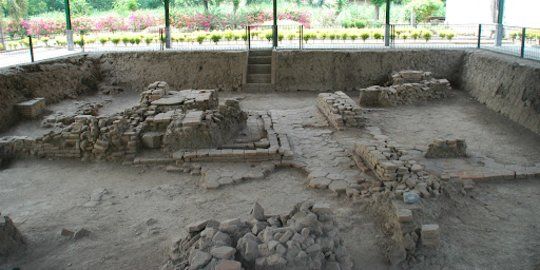
Dukuh Kedaton, Sentonorejo Village, Trowulan District, Mojokerto Regency, East Java, is believed to be the former palace of the Majapahit Kingdom. This belief is based on the interpretation of the Negarakertagama Book, aerial photographs, and excavations carried out.
Archaeologists suspect that Sentonorejo is a change from the word Santanaraja.
The allegation of the location of the Majapahit palace in Sentonorejo Village was strengthened by the findings of the Sentonorejo site in 1982. After conducting research, it was found that the remains of a hexagon floor were located about 1.8 meters below ground level.
This hexagon floor has a very unique shape, because we have never found a similar discovery in excavations at the Trowulan site. Usually only gravel and rectangular bricks.
The ancient floor arrangement is thought to be a relic of an ancient settlement site in the form of a residence during the Majapahit period. The location is suspected to be part of the VIP room of the Majapahit Palace.
In addition to the hexagon floor, in the area also found a variety of very fine pottery appearance.

Another finding that confirms the alleged location of the Majapahit Palace in Sentonorejo Village, Trowulan District is the existence of the Kedaton Temple site in Dukuh Kedaton.
Judged from the structure of the building, it is estimated that Kedaton Temple was a complex of buildings or residences. Artifacts that have been found around the temple building are fragments of pottery, terracotta areas, areas of andesite stone, foreign ceramics, kepeng currency, gold, and human skeletons.
In addition, 200 meters to the west of the Kedaton Temple complex, there are ancient relics in the form of 20 large pedestals. The pedestals are arranged in parallel and are oriented east-west.
Until now, the Kedaton Site still leaves a mystery. Archaeologists have not found the format of the site that has an upas well in front of the temple building. The site is estimated to consist of four temple buildings with upas wells, Islamic tombs, cave mouths, and secret passages.
The flat-shaped temple is thought to be a meeting room. While the mouth of the cave is suspected to be a place of meditation, and the secret passage is suspected to be an escape room.
The king's city of Majapahit or Wilwatiktapura is believed to be very broad to include several sub-districts in Mojokerto Regency. One of them is in Trowulan District, whose traces are still left today in the form of a number of temples, gates, ponds and lightning.
The archaeologist of the East Java Cultural Conservation Preservation Center (BPCB), Wicaksono Dwi Nugroho, said the existence of Wilwatiktapura was enshrined in the Negarakertagama Manuscript. That is about the journey of King Hayam Wuruk to Lumajang who departed from Wilwatiktapura in 1359 AD.
"According to my interpretation, Wilwatiktapura is wider than Trowulan District. It is indeed in Trowulan, but the area includes several sub-districts. Because many components of the king's city are described in the Negarakertagama Manuscript. For example Puri Bhre Wengker, Bhre Matahun, Bhre Tumapel and several other bhre, as well Mahapatih Gajah Mada's official residence," said Wicaksono.
Wicaksono continued, one of the descriptions of the breadth of Wilwatiktapura is contained in the pupuh 86 of the Negarakertagama Manuscript which explains how wide the Bubat Field was during the Majapahit era. According to him, the field for the big celebration in the king's city reaches 16 square km.
Plus archaeological findings at the Kumitir Site, Kumitir Village, Jatirejo District. The ancient building, which is believed to be the palace of Bhre Wengker and his wife, Bhre Daha, is surrounded by a 6-hectare fence. The Kumitir site is thought to be the eastern palace of Majapahit.
"If the area of the field and only one palace is that much, then Wilwatiktapura must be very large, not only in Trowulan District. This is my new interpretation. So we have to expand the area to look for the city planning of Majapahit," he explained.
Wicaksono believes that Wilwatiktapura was not surrounded by forts. He refers to the Yingyai Shenglan Chronicle, a record of Zheng He's expeditions, sailors envoys from the Ming Dynasty in China. The chronicle was written by Ma Huan, the translator of Zheng He. Ma Huan and Zheng He visited Majapahit in the 15th century AD.
"According to Ma Huan's records, Wilwatiktapura does not have a mobile fort. Only palaces are fortified, such as the Kumitir Site as the only site that has a 6-hectare wall as a palace. It is one complex, not yet another complex," he said.
** Your post has been upvoted (11.64 %) **
Curation Trail is Open!
Join Trail Here
Delegate more BP for bigger Upvote + Daily BLURT 😉
Delegate BP Here
Upvote
https://blurtblock.herokuapp.com/blurt/upvote
Thank you 🙂 @tomoyan